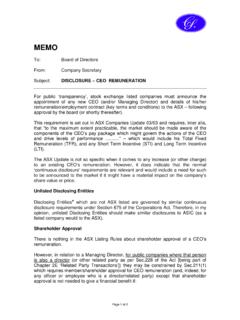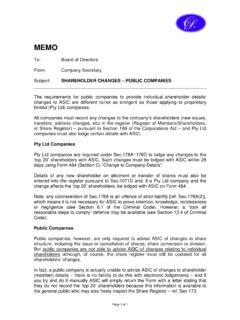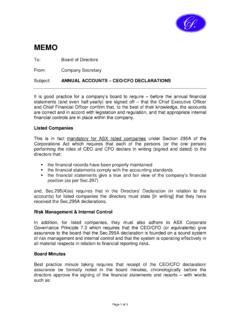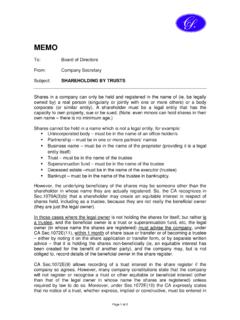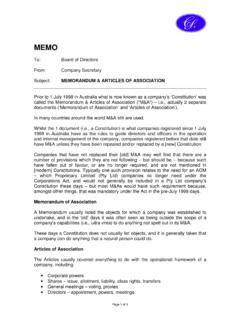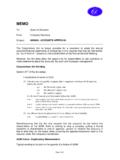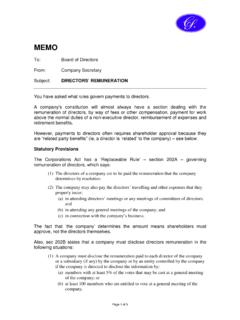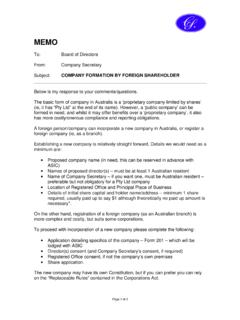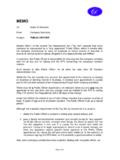Transcription of MEMO - companysecretary.com.au
1 Page 1 of 5 memo To: Board of Directors From: company secretary Subject: SHAREHOLDERS The shareholders (members) of a company are the owners of the company . In some companies the members do not hold shares; they are merely co-owners with a membership certificate. Such companies are typically charities or not-for profit companies and the liability of their members is limited by guarantee whereby the members have undertaken that if the company is in financial difficulties they will each contribute up to the amount of their guarantee, in need.
2 A member s guarantee is usually for only a nominal amount, typically between say $1 and $100, but may even be nil. On the other hand, in such companies members can never personally benefit from any profits the company might make. In most companies their members are shareholders ; they own a portion of the company , can benefit from the company s successes by receiving dividends paid out of profits, and the extent of their liability, which they would have to contribute to the company if in financial difficulties, is usually limited to the amount paid up (or payable if partly-paid shares) on their shares.
3 In fact, in a no liability company a shareholder does not even have to meet a call on partly-paid shares. The company itself has a separate legal existence and its assets belong to the company , and its liabilities, generally, have to be met by the company . A shareholder is not liable (in his capacity as a shareholder) for the company 's debts (other than for any amount unpaid on shares, if applicable). Whilst shareholders elect or appoint (or ratify board appointed) directors to manage the company on their behalf, shareholders can also make decisions about the company , its operations and its business, by passing resolutions, usually at a general meeting (and shareholders of proprietary companies can even pass resolutions by all signing a circulating resolution without actually meeting).
4 Shareholders can also vote to remove a director (subject to complying with the relevant provisions in the law). Becoming a Shareholder / Member All companies must have at least 1 member/shareholder. Proprietary companies must have no more than 50 shareholders, other than employee shareholders. There is no limit on the maximum number of shareholders/members of a public company . Page 2 of 5 A member must be an entity that can own property, sue or be sued either a real person, a body corporate ( a company incorporated under the Corporations Act or other jurisdiction), or a body politic ( an Australian State).
5 A business name is not a legal entity and therefore cannot be a member. Estates and trusts cannot hold shares in their own right; they must nominate an executor or a trustee. There is no age limit, so even if under 18 years a person can become a member of a company . Someone can become a shareholder/member of a company in one of a number of ways. They can: be listed as a member at the time of registration of the company . They must have given their written consent to be a member, and signed the constitution or agreed to using the Replaceable Rules (in the Act), before the application for registration is lodged with ASIC.
6 The names and addresses of all persons who have consented to be members form part of the application for registration as an Australian company . agree to become a member of a company after its registration with ASIC, in one of 2 ways: (i) by signing an application form whereby they agree to abide by the constitution, and paying for any shares they are being issued. The new member s name is then entered on the register of members/ shareholders and a membership/share certificate (or Holding Statement if uncertificated) is issued.
7 Additionally, the company is responsible for notifying ASIC of changes in share capital and, if a proprietary company , updating the top 20 shareholders. (ii) by transfer from one shareholder to another using a duly completed and signed (and duty stamped, if applicable) Share Transfer Form. The transfer must be lodged with the company and, subject to meeting any constitutional requirements (eg pre-emptive rights), the transferee s name is then entered on the register of shareholders and a share certificate/Holding Statement is issued.
8 Again, if applicable, for a proprietary company ASIC s top 20 shareholders must be updated. Shareholder Changes Most changes to a company s share capital and issued shares must be lodged with ASIC. In particular, proprietary companies must advise ASIC of any changes to shareholder details (including resulting from share transfers) and share structure including the issue or cancellation of shares, share conversion or division. Public companies are only required to advise ASIC of changes to share structure - including the issue or cancellation of shares, share conversion or division.
9 They are Page 3 of 5 not required (or, in fact, able) to advise ASIC of changes to shareholder (member) details. For obvious reasons a shareholder/member should inform a company of any change in address so that the company can update its register of shareholders (members). Additionally, a proprietary company is required to lodge any changes to the top 20 shareholders with ASIC. Shareholder Access to company Information Shareholders/members have limited access to certain company information, although public companies are required to provide more than proprietary companies.
10 Share Register The register of shareholders must be held at the company 's registered office or principal place of business (or other place approved by ASIC). It contains the name and address of each shareholder (member), share class, the number of shares held and the amount paid and unpaid on the shares. Anyone has a right to inspect and/or obtain a copy of a company 's share register (register of shareholders or members), provided they do not use the information in a manner or for uses prohibited by law.
